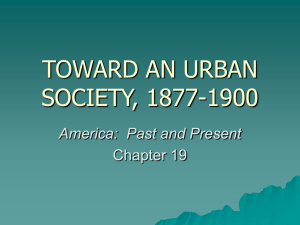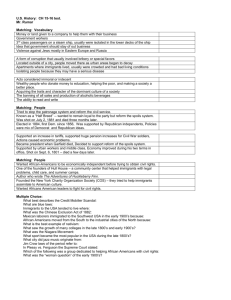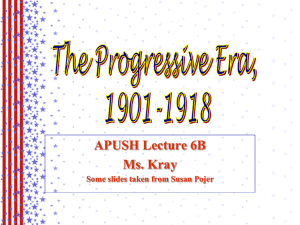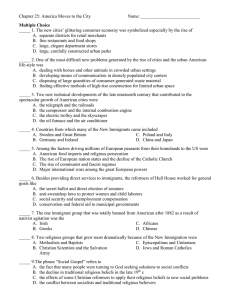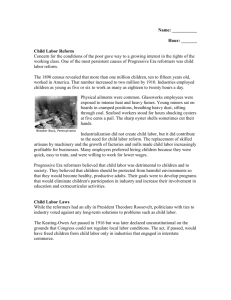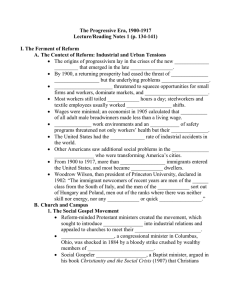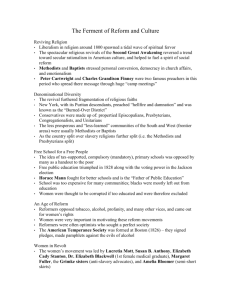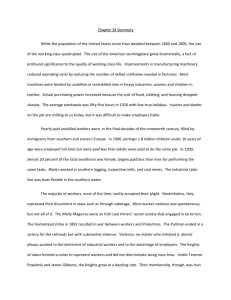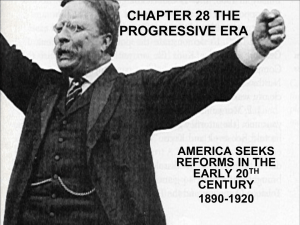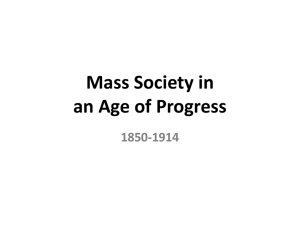Chapter 19 Summary - Biloxi Public Schools
advertisement
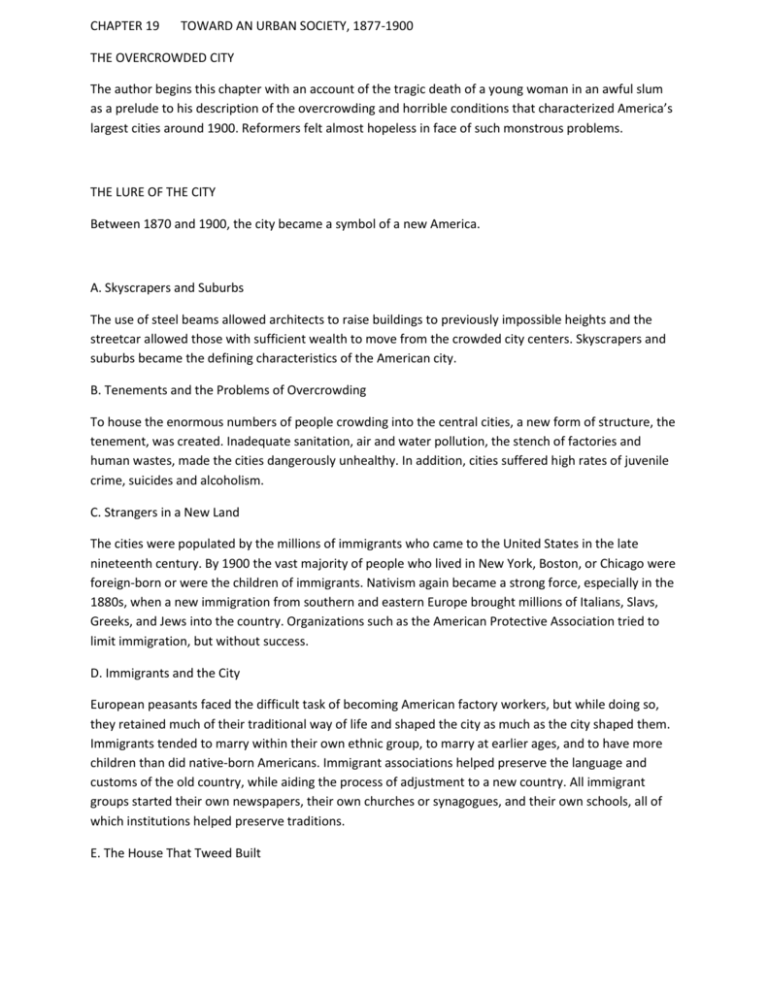
CHAPTER 19 TOWARD AN URBAN SOCIETY, 1877-1900 THE OVERCROWDED CITY The author begins this chapter with an account of the tragic death of a young woman in an awful slum as a prelude to his description of the overcrowding and horrible conditions that characterized America’s largest cities around 1900. Reformers felt almost hopeless in face of such monstrous problems. THE LURE OF THE CITY Between 1870 and 1900, the city became a symbol of a new America. A. Skyscrapers and Suburbs The use of steel beams allowed architects to raise buildings to previously impossible heights and the streetcar allowed those with sufficient wealth to move from the crowded city centers. Skyscrapers and suburbs became the defining characteristics of the American city. B. Tenements and the Problems of Overcrowding To house the enormous numbers of people crowding into the central cities, a new form of structure, the tenement, was created. Inadequate sanitation, air and water pollution, the stench of factories and human wastes, made the cities dangerously unhealthy. In addition, cities suffered high rates of juvenile crime, suicides and alcoholism. C. Strangers in a New Land The cities were populated by the millions of immigrants who came to the United States in the late nineteenth century. By 1900 the vast majority of people who lived in New York, Boston, or Chicago were foreign-born or were the children of immigrants. Nativism again became a strong force, especially in the 1880s, when a new immigration from southern and eastern Europe brought millions of Italians, Slavs, Greeks, and Jews into the country. Organizations such as the American Protective Association tried to limit immigration, but without success. D. Immigrants and the City European peasants faced the difficult task of becoming American factory workers, but while doing so, they retained much of their traditional way of life and shaped the city as much as the city shaped them. Immigrants tended to marry within their own ethnic group, to marry at earlier ages, and to have more children than did native-born Americans. Immigrant associations helped preserve the language and customs of the old country, while aiding the process of adjustment to a new country. All immigrant groups started their own newspapers, their own churches or synagogues, and their own schools, all of which institutions helped preserve traditions. E. The House That Tweed Built Political power in the cities was shared by various institutions, including party machines headed by “bosses.” Some of these men, like William Tweed of New York City, were notoriously corrupt, but most merely traded services for votes and improved conditions in their cities. SOCIAL AND CULTURAL CHANGES, 1877-1900 American life seemed much the same in 1877 as it had been a century earlier. Most Americans were white Anglo-Saxon Protestants who owned their own homes and led quiet, generally healthy lives. But urbanization and industrialization were changing all aspects of American life. A. Manners and Mores The late nineteenth century was Victorian in its morals. Middle-class men and women dressed and behaved “properly.” Religious values were still strong and underlay many of the reform movements aimed against alcohol, pornography, and political corruption. B. Leisure and Entertainment In general, Americans spent their free time at home playing cards or other parlor games. The general taste in music favored sentimental ballads, but ragtime was becoming popular. Outside the home, the circus was immensely popular, and organized baseball, football, and basketball began to attract fans. Street lights and streetcars changed Americans’‘ leisure habits. Evenings became time for entertainment and pleasure. C. Changes in Family Life Family relationships changed dramatically under the impact of urbanization and industrialization. Among the poorly paid segments of society, where everyone had to work, family life virtually disappeared. In middle-class families, the move to suburbia meant that the father commuted to work in the morning and was gone all day. Many middle-class women, who no longer earned an income, concentrated upon making their homes a domestic refuge from the outside world, but domesticity was never fully honored and it became almost shameful to be “just a housewife.” D. Changing Views: A Growing Assertiveness Among Women “New women,” those who established themselves in successful careers and who could support themselves, increasingly demanded the elimination of laws that discriminated against them, and spoke openly about topics, such as menstruation, that had long been considered forbidden subjects. E. Educating the Masses Even though the states required young people to attend school, few students reached the sixth grade. Until reformers like John Dewey became accepted, most teaching was unimaginative and routine, and students were not usually encouraged to be active in the classroom. The educational problems of the South were compounded by segregation and rural poverty. In 1896 the Supreme Court allowed “separate but equal” school systems, thus approving racial discrimination. F. Higher Education Colleges and universities flourished, thanks to aid from private sources and the federal government. There was greater emphasis on practical subjects such as medicine and nursing, and great research institutes such as Johns Hopkins were opened. Women found it easier to get a college education, but African Americans and other racial minorities were usually confined to institutions like Tuskegee, only for blacks. African- American leaders debated the future of higher education in a segregated society. Booker T. Washington argued that African Americans had to accommodate to racism and concentrate on practical, vocational education. W.E.B. Du Bois insisted that African Americans receive quality, integrated education. III. THE STIRRINGS OF REFORM The dominant idea among many intellectuals in the period was Social Darwinism, which held that attempts at reform in society were useless and harmful. Nevertheless, some thoughtful people began to argue that conditions in the United States had to be changed. A. Progress and Poverty One of the most influential books of the era was Henry George’s Progress and Poverty. George convinced many Americans that the rich were getting richer and the poor, poorer. His solution was to tax land, which he believed was the source of all wealth. B. New Currents in Social Thought George was not the only reformer. The “Social Gospel,” preached by liberal Protestant ministers, was an attempt to reform industrial society by introducing Christian standards into the economic sphere. C. The Settlement Houses Stanton Coit introduced London’s settlement-house idea to New York in 1886. The idea caught on and settlement houses, mostly staffed by women, spread around the nation. The best-known, Jane Addams’‘ Hull House in Chicago, offered classical and practical education to those who lived in the slums. The settlement-house movement inspired further reform and was influential in having a law passed in Illinois, in 1893, that limited the number of hours that could be worked by children under the age of fourteen. D. A Crisis in Social Welfare The depression of 1893 taught reformers that private charity was not enough. A new professionalism came into social work; attempts were made to study the conditions that created poverty, and reformers increasingly called for government intervention. CONCLUSION: THE PLURALISTIC SOCIETY The United States was a society in crisis between 1870 and 1900. Great disparities in wealth were developing, racial tension and labor unrest reached frightening dimensions, and an economic depression raised doubts about the continued existence of the nation.
